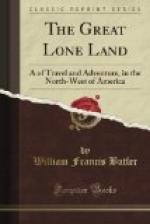Passing north-west from Fort Ellice, we enter the country of the Cree Indians, having to the north and east the Thickwood Crees, and to the south and west the Plain Crees. The former, under the various names of Swampies or Muskego Indians, inhabit the country west of Lake Winnipeg, extending as far as Forts Pelly and a-la-Corne, and from, the latter place, in a north-westerly direction, to Carlton and Fort Pitt. Their language, which is similar to that spoken by their cousins, the Plain Crees, is also a dialect of the Algonquin tongue. They are seldom found in large numbers, usually forming camps of from four to ten families. They carry on the pursuit of the moose and red deer, and are, generally speaking, expert hunters and trappers.
Bordering the Thickwood Crees on the south and west lies the country of the Plain Crees—a land of vast treeless expanses, of high rolling prairies, of wooded tracts lying in valleys of many-sized streams, in a word, the land of the Saskatchewan. A line running direct from the Touchwood Hills to Edmonton House would measure 500 miles in length, yet would lie altogether within the country of the Plain Crees. They inhabit the prairies which extend from the Qu’Appelle to the South Saskatchewan, a portion of territory which was formerly the land of the Assineboine, but which became the country of the Crees through lapse of time and chance of war. From the elbow of the South Branch of the Saskatchewan the Cree nation extends in a west and north-west direction to the vicinity of the Peace Hills, some fifty miles south of Edmonton. Along the entire line there exists a state of perpetual warfare during the months of summer and autumn, for here commences the territory over which roams the great Blackfeet tribe, whose southern boundary lies be yond the Missouri River, and whose western limits are guarded by the giant peaks of the Rocky Mountains. Ever since these tribes became known to the fur-traders of the North-west and Hudson Bay Companies there has existed this state of hostility amongst them. The Crees, having been the first to obtain fire-arms from the white traders, quickly-extended their boundaries, and moving from the Hudson Bay and the region of the lakes overran the plains of the Upper Saskatchewan. Fragments of other tribes scattered at long intervals through the present country of the Crees attest this conquest, and it is-probable that the whole Indian territory lying between the Saskatchewan and the American boundary-line would have been dominated over by this tribe had they not found themselves opposed by the great Blackfeet nation, which dwelt along the sources of the Missouri.
Passing west from Edmonton, we enter the country of the Rocky Mountain Stonies, a small tribe of Thickwood Indians dwelling along the source of the North Saskatchewan and in the outer ranges of the Rocky Mountains,-a fragment, no doubt, from the once-powerful Assineboine nation which has found a refuge amidst the forests and mountains of the West. This tribe is noted as possessing hunters and mountain guides of great energy and skill. Although at war with the Blackfeet, collisions are not frequent between them, as the Assineboines never go upon war-parties; and the Blackfeet rarely venture into the wooded country.




